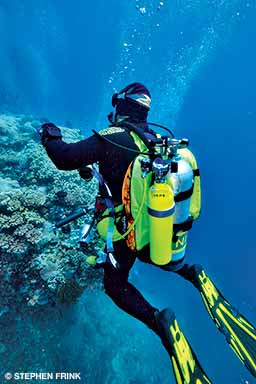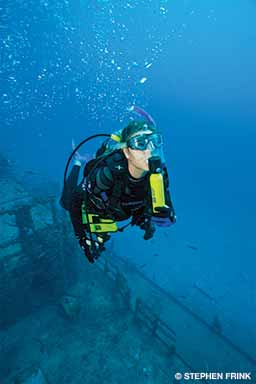My buddy-phone earpiece was crackling, but there was no mistaking the moment I heard Wes call out, “Need help!” An inhalation followed, and then he said, “Taking my last breath.”
We were filming a Hollywood feature, half-blind in a silt storm in a shallow cave in the Yucatán. Fourteen people were working on the shot when I yelled to our safety diver through the microphone in my full-face mask, “Joel, get to him! Fast!” With a long hose in hand, Joel practically climbed the cable that led to the camera and Wes, who had already removed his full-face mask when Joel arrived with breathing gas. It was a close call brought on by distraction and task loading. If an experienced professional like Wes could run out of air, anyone could.
I have donated emergency gas several times in my career: once for a hose rupture, twice for tank valves striking the ceiling of the cave and closing, and twice when a second stage fell off the hose, whipping us and creating a frightening explosion of bubbles. I have also escorted a few tourists back to a boat while they breathed off my octopus second-stage regulator. If you dive long enough, you will likely help another diver too.

Most people think of their octopus as their backup, but it won’t do any good if you have depleted the air in your scuba tank. An octopus is excellent for sharing air, and you may find yourself using it in case of a malfunction or loss of a mouthpiece. For genuine redundancy, however, you need an independent, alternate air source.
When I learned to dive in Canada, we always used pony bottles. I wore a 13-cubic-foot (0.4-cubic-meter) tank affixed to the side of my aluminum-80 cylinder with the second stage clipped to a chest D-ring. I used that small tank on my first liveaboard trip to the Bahamas until the dive crew nearly laughed me off the boat. Looking back, I realize I gave in to peer pressure by removing that little bottle. Today I would never allow another person to make a safety choice for me. If your friends tease you about being too conservative, then find some new dive buddies or tell them, “It’s better to carry air you don’t need than need air you don’t have.”
Many recreational divers think of the classic mini bailout bottle as their first and best option for redundancy. Several manufacturers make a small scuba tank with an integrated regulator that fits in a small waist pouch and is designed for self-use or to supply another diver. These products have a limited volume, however, usually between 1.7 and 6 cubic feet (0.05 and 0.2 cubic meters) and weighing from 1.5 to 3.7 pounds (0.7 to 1.7 kg). They come with a filler valve that facilitates recharge from a scuba tank.
It is essential to know the precise volume of gas available since not all bailout bottles have readable pressure gauges. Some indicators will show only if it is full or empty. The duration of breathing gas you get from a small bailout bottle will depend on your breathing rate. Manufacturers claim 114 breaths or 6 to 10 minutes at the surface for an average person using the 6-cubic-foot (0.2-cubic-meter) model. At 100 feet (30.5 meters), the supply will last a quarter of that time. If the bottle is underfilled or the diver is panicking, then the gas may last only a minute or two, significantly hampering the likelihood of a controlled ascent or safety stop.

If you think a small bailout bottle is right for you, consider a few other issues. Maintenance requirements will be similar to those for a full-sized scuba tank, including hydrostatic testing, so you should get a visual inspection (VIP) sticker. Make sure you can read the pressure gauge, and ask for help with mounting solutions. I wouldn’t consider the smaller options though, since the volume is so limited.
Don’t shop on price alone — look for reputable, familiar life-support manufacturers, and consider purchasing from a respected dive store. If the supplier says that you can quickly fill the tank with a bicycle-tire pump, go elsewhere. Although technically feasible with an expensive multistage pump, the heat of compression and time requirements make hand-pumping to 3,000 psi (207 bar) nearly impossible.
Another option for an alternate air source involves slinging a “bailout” or “stage” tank, which ranges from 13 to 80 cubic feet (0.4 to 2.3 cubic meters) and is equipped with a first stage, second stage, submersible pressure gauge and optional inflator hose. I use stretchy bands to hold everything snugly against the tank. My configuration has an upper clip on the tank neck connected to a chest D-ring and a lower clip attached to a ring on my hip, but other configurations are possible.
A bungee cord pulls the tank neck toward your armpit to make the cylinder secure and parallel with your body when swimming. Without a bungee, bailout bottles tend to ride perpendicular to the body, resulting in poor streamlining, entanglement hazards and opportunities for regulator damage. Most bailout bottles are aluminum rather than steel, so you don’t always have to offset them with a hip counterweight on your belt, but you may need to adjust your weights depending on factors such as positioning, cylinder size and your overall weighting needs. Practice removing and replacing your bailout tank while wearing your standard dive gloves so you can easily pass it up to the boat or give it to a needy diver.
The third option is diving sidemount style. With two tanks you will achieve genuine redundancy: You will have two separate gas supplies, each with an independent regulator. Although most divers use 80-cubic-feet (2.3-cubic-meter) or larger cylinders, recreational sidemount divers may prefer smaller tanks. Sidemount divers will get the best results with a custom fitting. Tanks must be well-balanced for your unique body, and your hose routing should result in clean streamlining. Training for using the sidemount technique is available to recreational and technical divers, but be sure to find an instructor with plenty of experience.
No matter which alternate air source you choose, learn to calculate your air consumption and regularly practice emergency procedures. There are many ways to configure each type of redundant breathing-gas supply, but make sure your setup matches your training, gear arrangement and dive objectives. If a naysayer thinks your equipment choice is unnecessary, let them know that the difference between a fatal accident and an embarrassing incident could come down to a breath or two. Any redundancy is better than none.
© Penyelam Siaga - Q3/Q4 2021